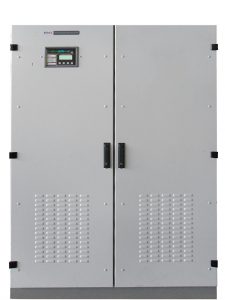On-Grid Inverter
On-Grid Inverter topology is based on 1 Full Bridge 2 High Frequency IGBT Inverter Modules (3 full-bridge 6 high  frequency IGBT modules for 3 Phase output) using PWM (pulse width modulation) and control logic based on DSP. Monitoring of electrical values and parameter adjustments can be done through Graphical Display and Mimic diagram of the ASTOR On-Grid Inverter system. EMC filters decrease the radio frequency emissions on the AC network and photovoltaic modules while Full Bridge High Frequency IGBT Inverter Modules convert direct current to alternating current. Isolation of DC input and AC output is ensured by galvanic Isolation Transformer at the output of the inverter. No load losses of the transformer is avoided by separating the inverter from AC output by contactor while inverter is in “OFF” position. All operations are controlled through Control PCBs and Graphical Display monitors the whole system.
frequency IGBT modules for 3 Phase output) using PWM (pulse width modulation) and control logic based on DSP. Monitoring of electrical values and parameter adjustments can be done through Graphical Display and Mimic diagram of the ASTOR On-Grid Inverter system. EMC filters decrease the radio frequency emissions on the AC network and photovoltaic modules while Full Bridge High Frequency IGBT Inverter Modules convert direct current to alternating current. Isolation of DC input and AC output is ensured by galvanic Isolation Transformer at the output of the inverter. No load losses of the transformer is avoided by separating the inverter from AC output by contactor while inverter is in “OFF” position. All operations are controlled through Control PCBs and Graphical Display monitors the whole system.
With an estimated 30 years life time, photovoltaic panels or generators are main source of producing direct current which is transformed to alternating current via inverters that form the heart of the system as their robust design should ensure the continuity of the supplied energy by also leveling up the output voltage to the electricity network voltage of the grid, staying synchronized with the mains frequency. The inverter must as well optimize the energy production with respect to the solar radiation by tracking the Maximum Power Point (MPP). Maximum Power Point Tracking, frequently referred to as MPPT, is a system that operates the Photovoltaic (PV) modules in a way that allows the modules to produce all the power they are capable of.
The sizing of photovoltaic panel power is generally more than the maximum power supplied by the inverter in order to offset the loss of power of the PV modules due to high operating temperature, dirt, cables and ageing. To obtain the desired power it is possible to connect more inverters in parallel to the Grid. Utilizing more inverters means placing more MPPTs with the result of being able to run each unit separately, optimizing the configuration and consequently the performance of the entire plant. Furthermore in the event of inverter malfunction, only the part involved in the malfunction is affected and not the entire production as in the case of the single inverter.
